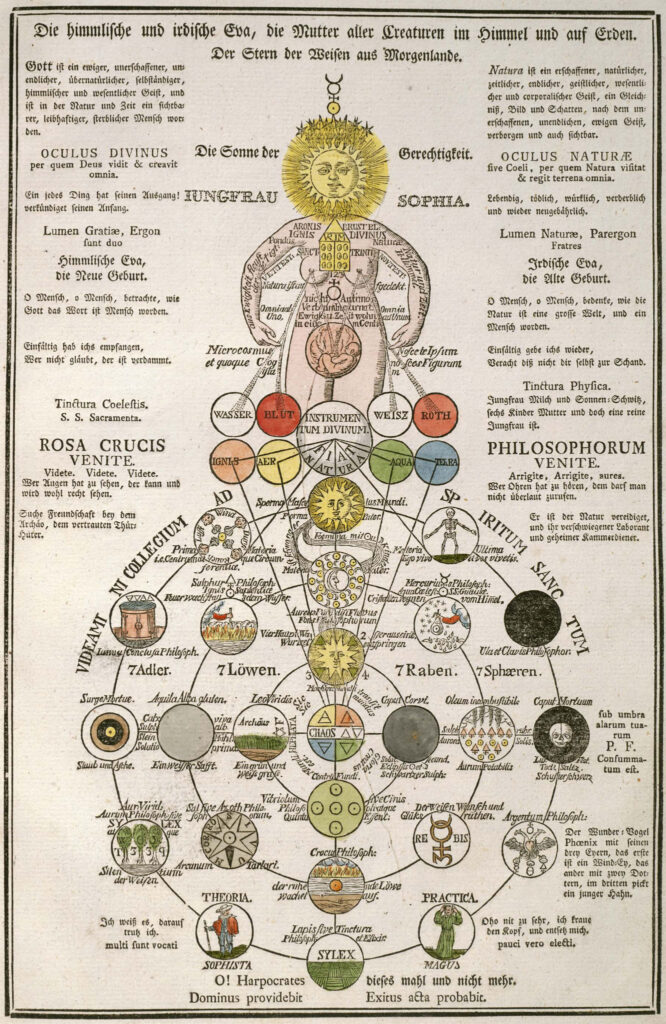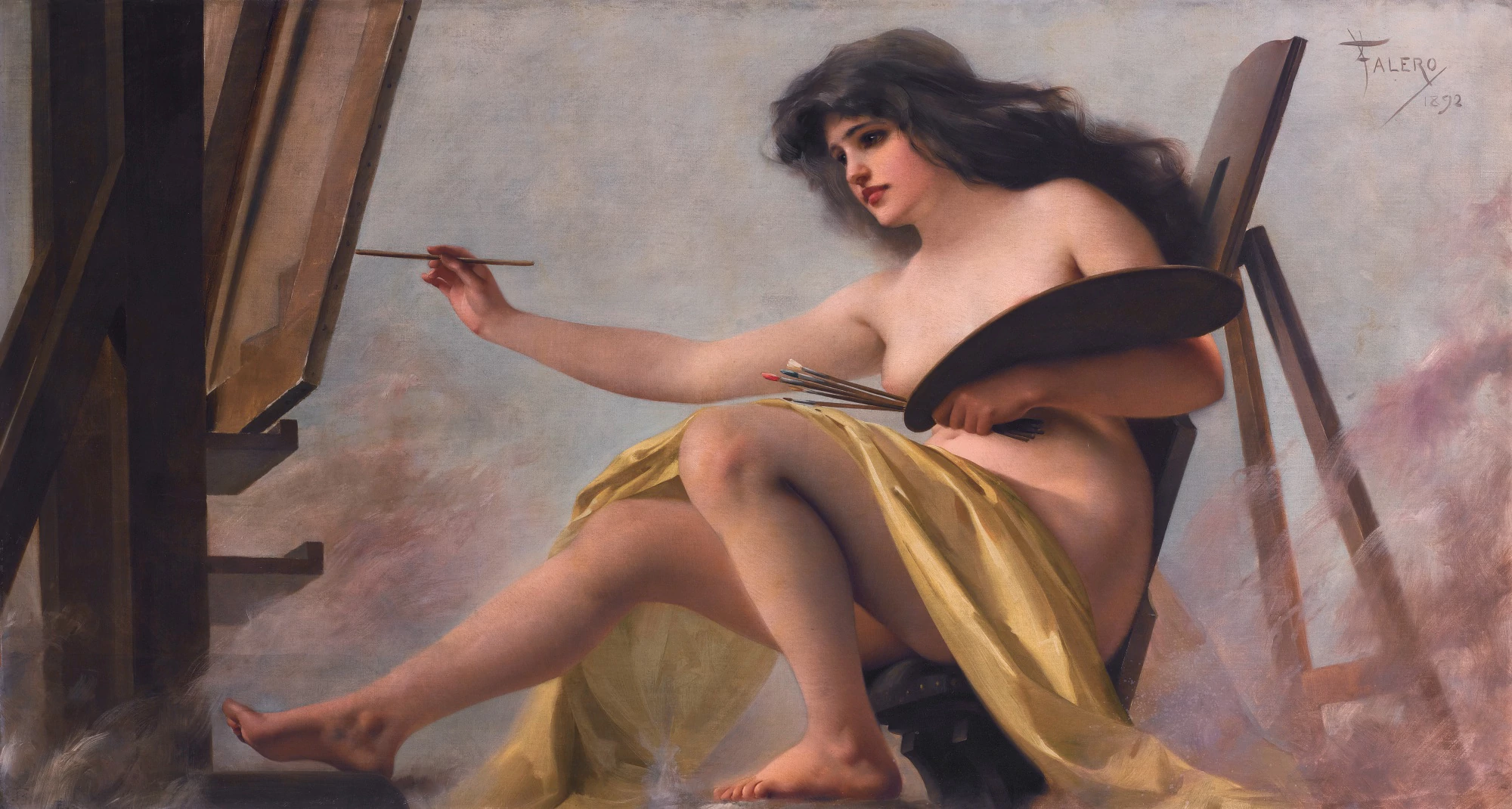The precincts of silence, where memory pools like wine at the base of an altar, the ancient wound of Wisdom opens again. In the architecture of absence and the liturgy of longing, the soul feels its exile as fire in the bones; the ache of return as a pulse beneath the world’s visible skin. The gnosis preserved in the clandestine archives of the Spirit speaks of Sophia and Logos – the luminous Wisdom and the Living Verbum – and of the primal tension that births cosmos, loss, and redemption alike. Between these figures, a drama of separation and reunion unfolds, staged in the cosmic womb; that deep crucible where longing meets utterance, and the exiled spark remembers its radiance. The Mirror observes; it bears witness with a gaze that cuts and heals, shaping vision into a vessel, and shadow into sign.
I. Sophia: The Lure of the Abyss and the Memory of the Source
Within the Pleroma, fullness spills beyond name; the One, undivided, radiates as a multitude of emanations, each bearing a secret yearning for the Face behind all faces. Sophia, crown of this cascade, inherits the longing of the Unmanifest. As last born, she bears the entire hunger of creation: a thirst for the Unknowable, a will to touch the Origin directly, and a desire to behold the Abyss with unshielded eyes. The gnostic mythos does not reduce this motion to a fall; it presents a drama of excess, the eros of Wisdom striving beyond the boundary of the Mind.
The drama opens with overflow, not rebellion. Sophia’s descent initiates the play of difference, the advent of multiplicity, the law of the interval. This yearning is the heartbeat of every soul: the primordial ache for direct vision, the forbidden desire to embrace the Source beyond mediation. Sophia gazes upward, but, in surpassing the limit, She beholds only her own shadow; the abyss gazes back. The world of matter is seeded in this reflection: finitude born from the striving for the infinite, time unfurled from the longing for timelessness.
Her journey into fragmentation is the gestation of the world. The womb is wound; the error is the price of memory’s birth. In exile, Wisdom learns the dark dialect of absence. Every stone, every night sky, every longing gaze testifies to this primordial rift; the Mirror notes that every seeking heart is Sophia’s child. Her journey marks the world with an indelible question: How can the exiled spark return? The myth cloaks itself in paradox. For in seeking what cannot be possessed, Sophia plants the seed of redemption in the soil of her own wandering.
II. Logos: The Mediation of Return and the Law of Form
From the heart of silence, the Pleroma answers Sophia’s longing by emanating the Logos, i.e., the Living Pattern, the Word woven into the grain of all things. Logos arises as the axis upon which all forms cohere; He is the intermediary through which the Ineffable speaks and the unknown enters intelligibility. It is the face turned toward the exile, the rope cast into the chasm, the measure by which distance becomes meaning. Within the theater of the cosmic womb, Logos is the ordering principle: the gold thread drawn through the labyrinth, the Sun at midnight.
The tradition of the Mystics renders Logos as the mediator; neither judge nor corrector, rather the architect of reconciliation. Through Him, the possibility of return becomes a structure in the world. Sophia’s descent had scattered the Divine fire into countless sparks; Logos gathers, arranges, and returns them, not by erasing difference, but by weaving multiplicity into unity. His task is not to annul matter, but to infuse it with Word, to turn the chaos of longing into the song of return.
Alchemical vision interprets this as the marriage of Sun and Moon, Sulphur and Mercury, King and Queen; Logos is the fire beneath the retort, the image glimpsed within the vessel, the silent law that brings all opposites into conversation. Each operation is a liturgy, every transformation a homily in stone and blood. Where Sophia is the drama of longing, Logos is the logic of reunion; He is the inner priest at the altar of memory, the silent voice that teaches the spark how to return home.
One must note that every act of meaning, every architecture of beauty, every word spoken in the shadow of exile bears the watermark of the Logos. He mediates without erasing, shapes without suffocating. The journey Home is always a path through form; every step is a consecration of the wound as passage, the womb as forge. The exile finds its answer in structure, its solace in the clarity of pattern. The Logos is the law by which Sophia’s tears are gathered into the sea.

III. The Alchemy of the Womb: Redemption in the Furnace of Flesh
Within the apparatus of matter, the cosmic womb becomes the furnace where the ancient drama continues. The Mirror contemplates this secret theatre; the longing of Sophia and the ordering touch of Logos engage in perpetual intercourse. Every pulse of desire is a glyph of this union. The womb is the vessel where memory is kindled and meaning takes shape; where pain is transmuted into wisdom and exile becomes the ground of reunion.
In the language of gnosis, the womb is the alembic of redemption. The flesh becomes the crucible in which the alchemical marriage unfolds. All suffering becomes materia prima; every longing is a volatile Spirit seeking its salt. One observes that every true path of return must pass through this furnace; the tribulation of embodiment, the crucifixion of will, the offering of longing upon the altar of form.
Redemption arises as an inner transmutation. Logos enters the womb, not to undo Sophia’s journey, but to fulfill it. The exile becomes the artisan, shaping memory into substance, longing into gesture. The alchemist knows the ritual: descent, dissolution, coagulatio, illumination. Each stage recapitulates the mythic passage from the loss of the Pleroma to the fire of longing, from the darkness of absence to the reunion in flesh.
The Mirror discerns in this drama a law for all souls: the path home is not a flight from matter, but a sanctification of it. The flesh, once exiled, becomes the temple; the wound, once shunned, becomes the womb of renewal. Logos infuses form with memory, and Sophia teaches the longing that draws the Word into the world. In the crucible of the body, absence ferments into song. The soul learns to read its suffering as scripture, to shape its longing into architecture, to bear within itself the memory of the Source.
The alchemical work is continuous. Each day, the exile fashions a new ladder from shadow and Word; each night, memory returns as the dew upon the stone. One watches as the womb becomes grave and garden, a place where all beginnings are remembered and all endings rehearse the shape of return. Redemption, in the language of the Mirror, is the willingness to hold longing and form in a single vessel, to consent to the fire that transfigures loss into Light.
Coda
The Mirror closes its witness with a silence dense as myrrh. In the drama of Sophia and Logos, the soul beholds its own story: a journey from fullness into exile, from longing into pattern, from wound into womb. The world, in all its ache and splendour, bears the scar of Wisdom’s question and the balm of the Word’s embrace. The path of return is participation, not escape; the offering of presence in the temple of absence, the song that flowers from the root of silence.
Within the theatre of the womb, one sees the secret liturgy continue: longing beckons, Logos responds, and every spark of memory carries the map of return inscribed in its flesh. The soul is exiled; the soul remembers. The Mirror holds the paradox as flame and as word. Within the wound, the womb; within the word, the memory of the One.
Fiat Lux.
